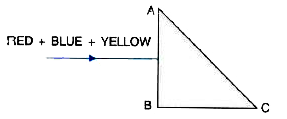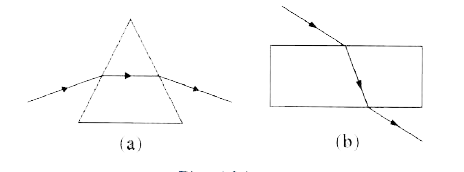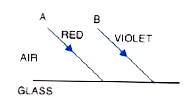Fig. shows a light (blue + red + green) incident on a prism and on a parallel sided glass slab. Complete the diagrams by drawing the refracted and the emergent rays.
(##SEL_RPG_ICSE_PHY_X_C06_SLV_001_Q01.png" width="80%">
To solve the problem of drawing the refracted and emergent rays for light incident on a prism and a parallel-sided glass slab, we will follow these steps:
Step 1: Understanding Refraction in a Prism
1. Identify the Incident Ray: The light consisting of blue, red, and green colors is incident on the prism.
2. Draw the Prism: Sketch the prism shape, which is typically a triangular shape.
Step 2: Drawing the Refraction at the Prism
1. First Surface Refraction: When the incident light hits the first surface of the prism, it will bend towards the normal due to refraction.
- Draw Refracted Rays: Draw three refracted rays for blue, red, and green light, bending towards the normal line at the first surface.
2. Second Surface Refraction: As the light exits the prism, it will refract again at the second surface.
- Draw Emergent Rays: Draw the emergent rays for blue, red, and green light bending away from the normal line at the second surface.
Step 3: Understanding Refraction in a Parallel-Sided Glass Slab
1. Identify the Incident Ray: The same light (blue, red, and green) is incident on the parallel-sided glass slab.
2. Draw the Glass Slab: Sketch a rectangular shape to represent the glass slab.
Step 4: Drawing the Refraction at the Glass Slab
1. First Surface Refraction: When the incident light hits the first surface of the glass slab, it will also bend towards the normal.
- Draw Refracted Rays: Draw three refracted rays for blue, red, and green light bending towards the normal line at the first surface.
2. Second Surface Refraction: As the light exits the glass slab, it will refract again at the second surface.
- Draw Emergent Rays: Draw the emergent rays for blue, red, and green light bending away from the normal line at the second surface. The emergent rays will be parallel to the incident rays.
Final Diagram
- Ensure that the refracted and emergent rays are clearly labeled with their respective colors (blue, red, green) to illustrate the dispersion of light.
1. Identify the Incident Ray: The light consisting of blue, red, and green colors is incident on the prism.
2. Draw the Prism: Sketch the prism shape, which is typically a triangular shape.
1. First Surface Refraction: When the incident light hits the first surface of the prism, it will bend towards the normal due to refraction.
- Draw Refracted Rays: Draw three refracted rays for blue, red, and green light, bending towards the normal line at the first surface.
2. Second Surface Refraction: As the light exits the prism, it will refract again at the second surface.
- Draw Emergent Rays: Draw the emergent rays for blue, red, and green light bending away from the normal line at the second surface.
1. Identify the Incident Ray: The same light (blue, red, and green) is incident on the parallel-sided glass slab.
2. Draw the Glass Slab: Sketch a rectangular shape to represent the glass slab.
1. First Surface Refraction: When the incident light hits the first surface of the glass slab, it will also bend towards the normal.
- Draw Refracted Rays: Draw three refracted rays for blue, red, and green light bending towards the normal line at the first surface.
2. Second Surface Refraction: As the light exits the glass slab, it will refract again at the second surface.
- Draw Emergent Rays: Draw the emergent rays for blue, red, and green light bending away from the normal line at the second surface. The emergent rays will be parallel to the incident rays.
- Ensure that the refracted and emergent rays are clearly labeled with their respective colors (blue, red, green) to illustrate the dispersion of light.
Topper's Solved these Questions
- BOOK - ICSECHAPTER - SPECTRUMEXERCISE - EXERCISE A40videos
SPECTRUM
- BOOK - ICSECHAPTER - SPECTRUMEXERCISE - EXERCISE A (MULTIPLE CHOICE TYPE)6videos
SPECTRUM
- BOOK - ICSECHAPTER - SPECIMEN QUESTION PAPEREXERCISE - QUESTIONS33videos
SPECIMEN QUESTION PAPER
- BOOK - ICSECHAPTER - WORK,POWER AND ENERGY EXERCISE - DIAGRAM BASED MCQ3videos
WORK,POWER AND ENERGY
Similar Questions
Match the properties and uses of alloys in List 1 with the appropriate answer from List 2.
(##EVRBLKICSECHEX_C07E06054_Q01.png width=80%>View SolutionCalculate the angles x,y and z if
x3=y4=z5
(##SEL_RKB_ICSE_MAT_X_C17_E02_042_Q01.png" width="80%">View SolutionTwo cars A and B move in mutually perpendicular, directions as shown in the figure . Find vBA
(##AAK_T1_PHY_C02_SLV_051_Q01.png" width="80%">View SolutionIn the given figure. A is the centre of the circle , ABCD is a parallelogram and CDE is a straight line.
Prove that :∠BCD=2∠ABE
(##SEL_RKB_ICSE_MAT_X_C17_E02_036_Q01.png" width="80%">View SolutionUsing the informations given in the adjoining figure , write the sides of ΔBOC in ascending order of length.
(##SEL_RKB_ICSE_MAT_IX_CR_01_E01_171_Q01.png" width="80%">View SolutionIn the given figure. AB is the diameter of the circle with centre O.
(##SELRKBICSEMATX_C17E04012_Q01.png width=80%><br>If angle ADC = 32 ^(@) , find angle BOC.View SolutionA beam consisting of red, blue and yellow colours is incident normally on the face AB of an isosceles right angled prism ABC as shown in Fig. 6.5. Complete the diagram to show the refracted and the emergent rays. Given that the critical angle of glass-air interface for yellow colour is 45∘
 View Solution
View SolutionDiagram (a) and (b) in figure below show the refraction of a ray of light of single colour through a prism and a parallel sided glass slab respectively.

(i) In each diagram, label the incident, refracted, emergent rays and the angle of deviation.
(ii) In what way the direction of the emergent ray in the two cases differ with respect to the incident ray ? explain your answer.View SolutionThe given diagram is highly diagrammatic representation of mammalian heart. In this diagram
(##EVR_ANM_ICSE_BIO_X_C07_E01_020_Q01.png" width="80%">
What do the arrows indicate ?View SolutionThe diagram below shows two parallel rays A and B of red and violet light respectively incident from air on air-glass boundary. Complete the diagram showing the refracted rays for them in the glass.

(i) How do the speeds of the rays differ in glass ?
(ii) are the two refracted rays in glass parallel ?
Give a reason for your answer.
(iii) How does the refractive index of glass differ for the two rays ?View Solution

